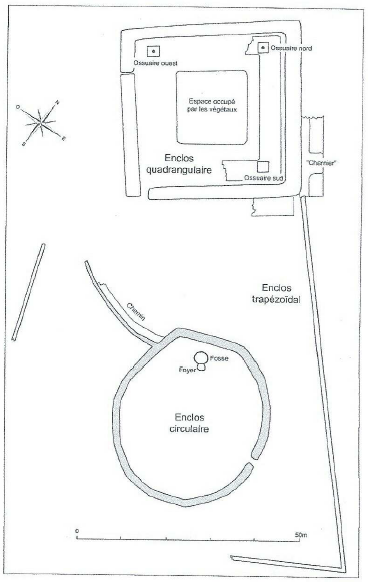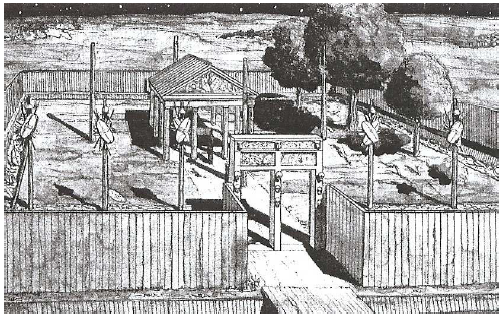A) Gaulish Sanctuaries devoted to War-Deities
The sanctuary of Ribemont-sur-Ancre, dating from the 1st half of the 3rd c. BC, is composed of two enclosures different in shape, use and function: a 40 m2 quadrangular enclosure discovered in 1982 and a polygonal enclosure, situated forty metres away, unearthed in 2001.1441 Impressive amounts of iron weapons (swords, scabbards, spears, shields) together with human bones (legs, arms, pelvises, hands, feet, etc) belonging to about 1,000 men aged between 15 and 40 years old were collected in the two enclosures. The homogeneity and impressive number of human skeletons found together with their offensive weapons indicate that a battle took place in the area. The quadrangular enclosure was originally erected on a wooded mound which later became a sacred wood where the deity resided and human beings were not allowed (fig. 11). Around 20,000 metal pieces and human skeletons in pieces with no skulls, belonging to about 150 individuals, were excavated in this enclosure. According to Brunaux, these remains are undoubtedly those of enemy warriors killed in action.1442 While the skulls were kept by the victors as proof of their bravery - which is why they are missing from the ‘mass grave’ - the rest of the corpses together with their weapons and jewels were brought to the sanctuary as an offering to the war deity. Three ‘charnel houses’, i.e. cavities hollowed in the ground filled to the top with human and horse bones, were unearthed in the north-east, north-west and south-west corners of the enclosure.1443 These concave altars are understood as offering wells dedicated to the war deity dwelling in the enclosed sacred wood. The organization and function of the polygonal enclosure is studied earlier in this chapter.
Similarly, the sanctuary of Gournay-sur-Aronde, like those of Saint-Maur, Morvilliers-Saint-Saturnin and Estrées-Saint-Denis, is undoubtedly a war sanctuary, for significant and impressive amounts of human skeletons and weapons were excavated there.1444 Contrary to Ribemont-sur-Ancre, Gournay-sur-Aronde was not erected after a specific battle and does not consist of skeletons and weapons coming from a homogenous mass. The analysis of the weapons found on the site (250 pieces of armour, comprising each time a sword with its scabbard, a shield and a spear) reveals considerable geographical and chronological disparity. The weapons indeed date from the beginning of the 3rd c. BC to the middle of the 2nd c. BC, spreading thus over a period of 120 or 130 years, and come from various places and peoples. Gournay-sur-Aronde can therefore be understood as a sanctuary where warriors used to go to pray and pay homage to a war deity by depositing and offering their trophies and spoils of war. The sanctuary is made of a massive enclosure, composed of an impressive fence and a double ditch, with an imposing entrance door, where the skulls of the foes were nailed up and the weapons exposed for several years until oxidization, before being thrown into the trench (fig. 12). In the centre of the enclosure was situated a hollow or concave altar where entire bovids were deposited as an offering to the god and left to decompose and rot. Putrefaction of the corpses and corrosion of the weapons was part of a whole sacred rite held in honour of the martial deity. A small wood, materializing the divine presence, was located to the north of the offering well.


The two sanctuaries produce evidence of a significant cult rendered to war deities in Celtic times, but they unfortunately do not give information on the identity of those divinities. Neither do the Classical texts shed light on that subject. The only reference to a martial goddess is made by the Greek historian Dio Cassius in his History of Rome (LXII, 6). Dio Cassius recounts the historical rebellion of Queen Boudicca against the Roman invasion in 60 AD. Boudicca, whose name means ‘the Victorious’,1445 was the wife of Pratustagus, the leader of the Iceni, a tribe situated in today Norfolk, in eastern Britain.1446 After her husband was slaughtered by the Romans, she raised a revolt, with the help of the neighbouring sept*, the Trinovantes, and plundered and burnt the Roman cities Camulodunum (Colchester) and Londinium (London). Dio Cassius specifies that Boudicca required the divine help and protection of a goddess named Andraste, whose name was explained by Holder as An-drasta, ‘the Invincible’, with a negative prefix an, ‘non’ and a root drastos, ‘to vanquish, to oppress’.1447 While invoking the goddess, Boudicca let a hare abscond from her breast to foresee the forthcoming turn of events:
‘At these words, employing a species of divination, she let a hare escape from her bosom, and as it ran in what they considered a lucky direction, the whole multitude shouted with pleasure, and Buduica raising her hand to heaven, spoke: "I thank thee, Andraste, and call upon thee, who are a woman, being myself also a woman that rules not burden-bearing Egyptians like Nitocris, nor merchant Assyrians like Semiramis (of these things we have heard from the Romans), nor even the Romans themselves, as did Messalina first and later Agrippina;--at present their chief is Nero, in name a man, in fact a woman, as is shown by his singing, his playing the cithara, his adorning himself:--but ruling as I do men of Britain that know not how to till the soil or ply a trade yet are thoroughly versed in the arts of war and hold all things common, even children and wives; wherefore the latter possess the same valour as the males: being therefore queen of such men and such women I supplicate and pray thee for victory and salvation and liberty against men insolent, unjust, insatiable, impious,--if, indeed we ought to term those creatures men who wash in warm water, eat artificial dainties, drink unmixed wine, anoint themselves with myrrh, sleep on soft couches with boys for bedfellows (and past their prime at that), are slaves to a zither-player, yes, an inferior zither-player. Wherefore may this Domitia-Nero woman reign no more over you or over me: let the wench sing and play the despot over the Romans. They surely deserve to be in slavery to such a being whose tyranny they have patiently borne already this long time. But may we, mistress, ever look to thee alone as our head."1448 ’Further on in the text, Dio Cassius, referring to the sack of the two Roman cities by Boudicca, describes the atrocities committed on the prisoners in sacred places, notably in the ‘grove of Andate’, whom he equated with the Roman goddess Victory. Andate is highly likely to be the same goddess as Andraste. This shows the uncertainty of Dio Cassius as regards the exactitude of the name of the goddess honoured by the Iceni. Not being mentioned in any inscriptions, the spelling and meaning of the divine name Andraste or Andate remain quite uncertain. Some British scholars suggest that the names Andraste and Andarta are philologically linked and thus refer to the same deity.1449 This is however quite difficult to believe, for their respective names do not seem to have the same composition: An-draste (‘Unconquerable’) and And-arta (‘Great Bear’).
‘After a harangue of this general nature Buduica led her army against the Romans. The latter chanced to be without a leader for the reason that Paulinus their commander had gone on an expedition to Mona, an island near Britain. This enabled her to sack and plunder two Roman cities, and, as I said, she wrought indescribable slaughter. Persons captured by the Britons underwent every form of most frightful treatment. The conquerors committed the most atrocious and bestial outrages. For instance, they hung up naked the noblest and most distinguished women, cut off their breasts and sewed them to their mouths, to make the victims appear to be eating them. After that they impaled them on sharp skewers run perpendicularly the whole length of the body. All this they did to the accompaniment of sacrifices, banquets, and exhibitions of insolence in all of their sacred places, but chiefly in the grove of Andate,--that being the name of their personification of Victory, to whom they paid the most excessive reverence.1450 ’As the places of worship and the Classical texts do not give information, the identity of the Gallo-British goddesses of war can only be reconstructed through the study of the few existing iconographical samples and the meaning of the divine names.